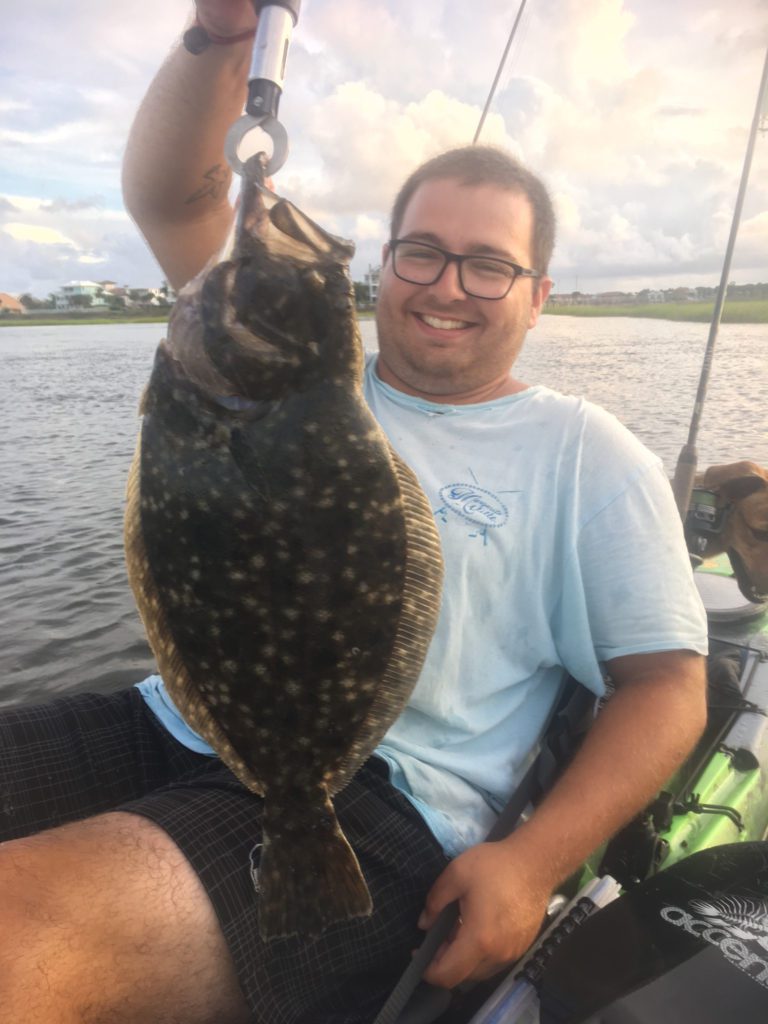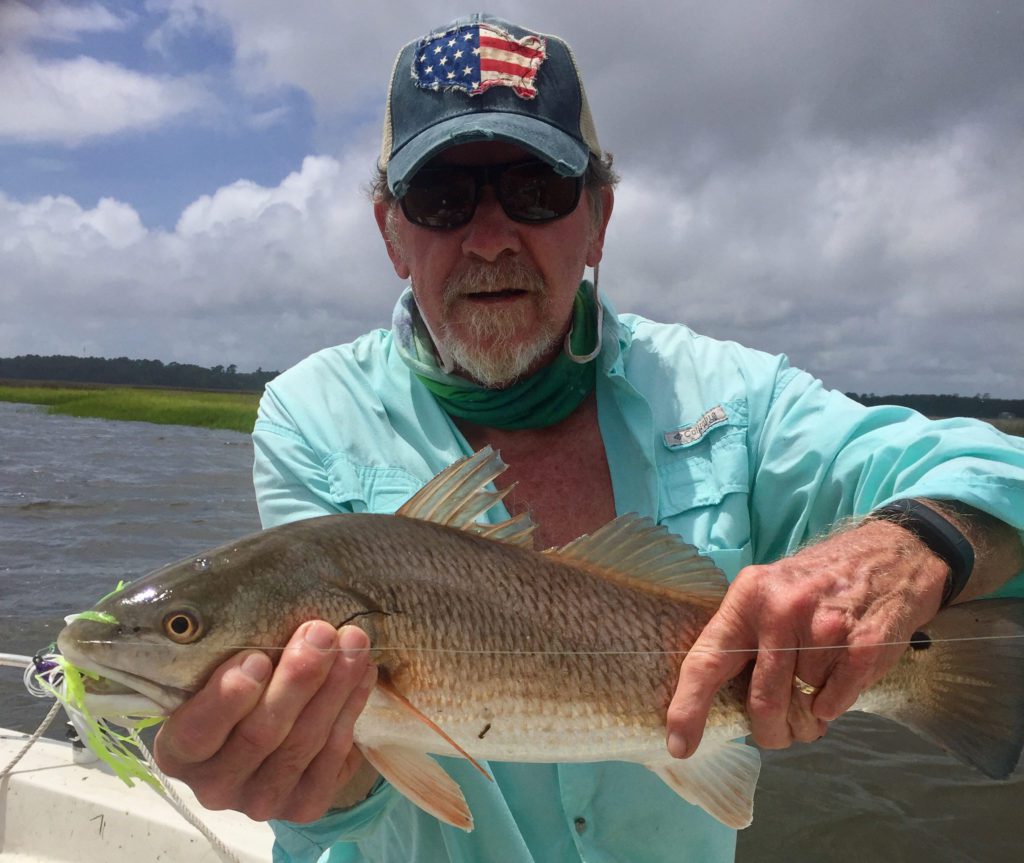Carolina Beach – August 31,2017
Lewis, of Island Tackle and Hardware, reports that fishing the surf on the bottom with fresh shrimp and sand fleas has landed good numbers of whiting, flounder, and pompano. On cut bait, anglers have caught a few mid-slot red drum.
Bluefish have been holding around the piers, and tossing metal jigs and Gotcha plugs has been the best method.
In the Cape Fear River and waterway, anglers have landed good numbers of red and black drum by targeting docks, rocks, and oyster structure.
Speckled trout fishing has picked up a bit. The biggest numbers of fish have been hanging around marsh points and banks, as well as shell banks. Most anglers are having success tossing topwater plugs early in the morning and then live shrimp under popping corks during the day.
Flounder are still feeding well inshore and have preferred live finger mullet and pogies on Carolina rigs.
Nearshore, those targeting wrecks and structure just off the beach have hooked in to some citation red drum. Fishing live baits and cut baits on the bottom has been the ticket. The flounder have also been steadily feeding nearshore. Dropping live baits, as well as bucktails tipped with soft plastics, has worked well to land good numbers of keeper fish.
Trolling Clarkspoons has produced plenty of action with keeper spanish just off the beach and out to around the 5 mile mark. In the 10 mile range, kings have been holding and are willing to take a trolled cigar minnow.
Around 23 Mile Rock, some mahi have been landed, but the mahi fishing in general has been hit or miss. A few blackfin tuna have been mixed in.
Out at the Gulf Stream, the wahoo bite has picked up.

Paul Hashem with a 22” flounder that fell for a bucktail tipped with a Gulp shrimp. He was kayak fishing a creek near Snow’s Cut.
Christian, of Seahawk Inshore Fishing Charters, reports that those targeting redfish inshore have found good numbers recently. Live finger mullet hooked on a Carolina rig has been the best way to tempt them to bite. A few flounder and speckled trout have also been hanging around with the reds, and keeper flounder continue to be mixed in with undersized fish.
Just off the beach, the spanish bite has heated up. Schools of spanish mixed with bluefish, ladyfish, and jack crevalle have been feeding near the mouth of the Cape Fear River. Anglers have had success tossing metal jigs to them.
Nearshore, the bull redfish action has started to heat up. Anglers fishing with large cut baits on the bottom have landed over-slot fish (in the 30-35” range).
Greg, of TopWater Guide Co., reports that flounder fishing has picked up around the inlets and in the waterway. Targeting docks with live mud minnows and finger mullet pinned on a Carolina rig has been the ticket. Most flounder have been right at the keeper mark (and ranged in size up to 18”).
The red drum bite has stayed steady for anglers targeting docks and bays in the river. In the shallow bays, topwater lures have worked well in the morning hours. During the day, live minnows on Carolina rigs have worked best near docks and oyster structure in the Cape Fear River.
Speckled trout fishing has been consistent, but the best bite has been during the first 2-3 hours of the day. Targeting marsh banks with 4-5′ of water, as well as shell banks in the river, has produced fish in the 2-3 lb. range. Topwater lures and live baits under float rigs have been the ticket.
Rod, of OnMyWay Charters, reports that spanish fishing just off the beach and out to the 4 mile range has been hot. Double digit days of fish in the 2-4 lb. class (with a few pushing the 6 lb. mark) have been common while trolling Clarkspoons in 20-50′ of water. Bluefish in the 2-4 lb. range have also been hooked while trolling near the beach, and undersized kings have been mixed in with the spanish, too.
Out to the 15-20 mile range, keeper kings have been landed in good numbers, with most fish anywhere from 10-25 lbs. Tolling Drone spoons and dead baits has been the ticket.
Mahi have been holding in the 20-25 mile range. Most fish have been scattered, but the best bite has come between 90-115′ of water. Large barracudas have also been present in this range.
On the bottom around the 20 mile mark, there are some beeliners, black sea bass, small grouper, and snapper. In the 30-40 mile range, the bottom fishing has been much more consistent, with keeper grouper, black sea bass, and beeliners.
Out at the Gulf Stream, the wahoo bite has started to turn on. The fish haven’t shown up in great numbers yet, but anglers covering water have found a few fish. Blackfin tuna and sailfish have also been feeding out at the Stream, although all have been scattered.

Roger Miller with a red drum that bit a jig in the Cape Fear River.
Jesse, of Ocean Stinger Fishing Charters, reports that the spanish and bluefish bite has picked up. Large numbers of fish are being landed while trolling #00 silver Clarkspoons on #1 and #2 planers. Targeting bait balls, structure, and ledges has been the best way to put quality fish in the boat.
Nearshore in 90-110′ of water, the mahi bite has been solid. Small blue/white and red/white Ilanders rigged with small ballyhoo have been the best combos for landing fish.
In 60-75′ of water, the king bite has been consistent. Anglers pulling white/silver Drone spoons have done best with the kings.
Around the Swansboro Hole, the wahoo bite is starting to pick up. Pulling black/purple Ilanders rigged with large ballyhoo has produced some quality fish in the 30-50 fathom range.
Woody, of Kure Beach Pier, reports that those tossing out fresh shrimp and sand fleas on the bottom have landed whiting, croaker, pompano, and flounder.
At the end of the pier, a nice king was landed, as well as a tarpon.
Bobbi, of Carolina Beach Pier, reports that the main target for anglers has been bottomfish. Croaker, flounder, and whiting have all been feeding, and fresh shrimp and sand fleas have been the ticket.
